- HIT THE DECK
- Posts
- Tech-tonic shifts
Tech-tonic shifts
What your CTO wishes Finance understood about Technology
"Everything with a f**king power cable gets dumped in my budget" - grizzled CTO
Monthly business review. You’re in full swing. Property costs? Sorted. HR initiatives? Check. Then your CFO asks that dreaded question:
"So what's driving that big technology spend?"
Everyone takes a deep breath.
"Let's come back to that one at the end," your manager suggests.

Why?
Because technology is tough. Unlike property or HR, technology can feel abstract, everywhere and nowhere at once. When technology costs are spread across the company, how do you explain what the function delivers (and if it is doing a good job)?
But what if there was a way to make technology spend more relatable and understandable…both to you and your management? With two key frameworks, we can transform how we understand the technology function.
Welcome back to our head office deep-dive series. Last time, we explored the broader challenges of central overheads. This week, we're zooming in on arguably the most complex piece of the puzzle: Technology.
WHY IS TECHNOLOGY A DIFFERENT BEAST?
IT’S CONCEPTUALLY DIFFICULT
When discussing property costs, everyone can visualize rent, desks, and coffee machines. But try explaining "cloud architecture optimization" & “API integrations” to your CFO and watch their eyes glaze over…
IT’S EVERYWHERE
IT Helpdesk ticketing system
Finance planning tools
Legal contract management software
Every part of the company has their own tech footprint & each creates their own spider web of costs, ownership, and accountability to unravel
THE GENERAL LEDGER DOESN’T MAKE IT EASY
On top of all that, typical GL reporting either:
Lumps everything into "IT Costs" , or
Spits out a laundry list of random vendor names (Burp Suite 👀 ???)
RUN VS CHANGE NIGHTMARE
It’s a microcosm of the head office problem - “Technology” encompasses all manner of spend
Business-as-usual costs
Project spend
Tech debt
Seeing the wood from the trees is no easy feat when it comes to understanding the run rate of your technology function.

All of that to say...tech is a tough nut to crack. Difficult to understand, difficult to explain, difficult to discuss.
TWO FRAMEWORKS THAT CHANGE EVERYTHING

But before you throw your laptop out the window (adding to IT’s overspend), let's meet two frameworks that can transform how we view technology costs.
BUSINESS NEED HIERARCHY
In our last issue, we shifted our head office perspective - farewell cost centres, hello service centres.
Service centres that address specific BUSINESS NEEDS.
Rather than an opaque set of costs, we need to remember every technology cost serves to address a specific business requirement.
Starting with the business needs helps build up a picture that actually helps us and the business understand what’s going on:
Let’s picture how we view any head office service:
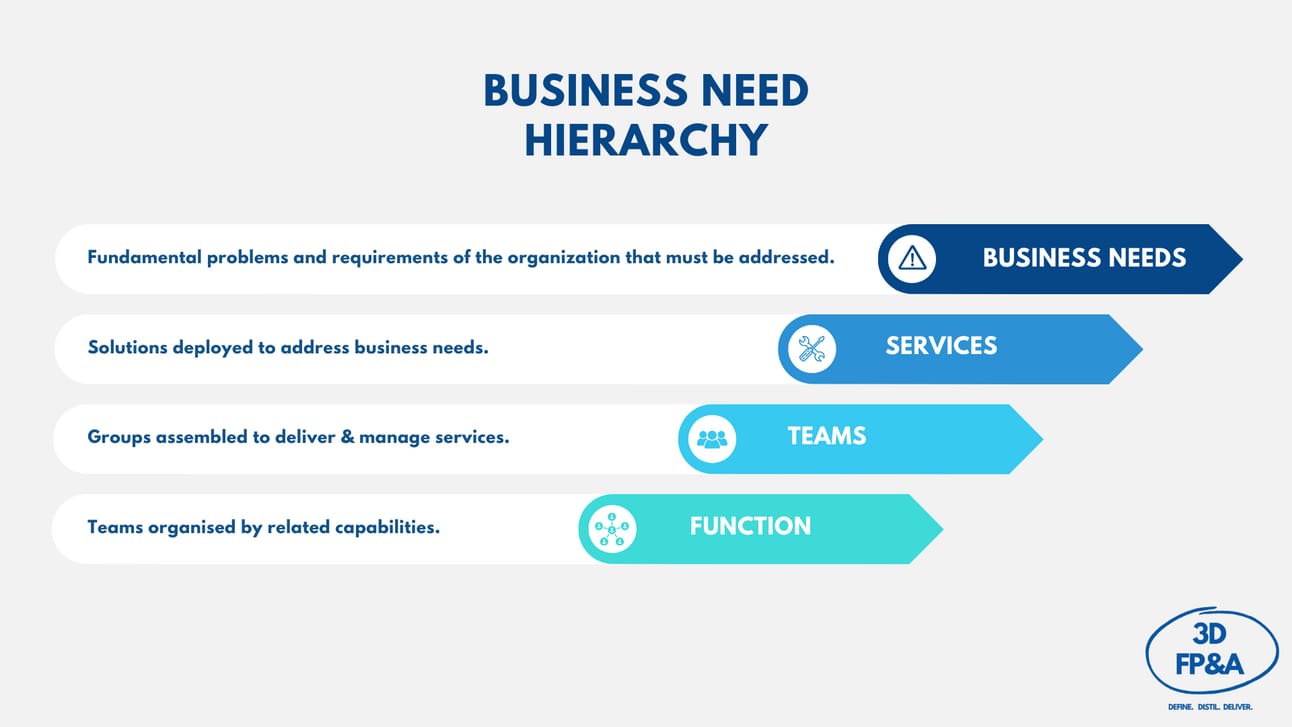
Take a simple example we can all relate to: what happens when an employee's laptop stops working?
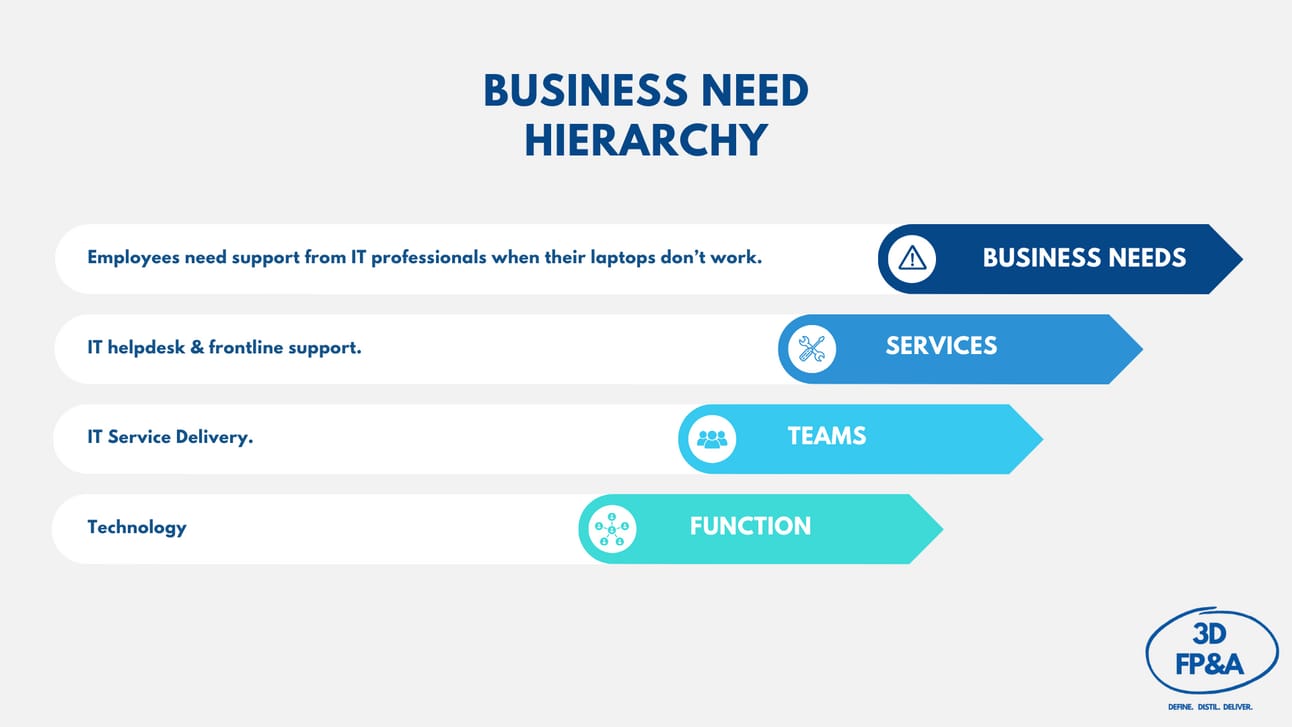
Think of it as following the money from problem to solution. So next time someone questions why their division's technology recharge is so high, we can have a better conversation by understanding:
the service required to address their business needs
the current level of service delivered &
the cost to deliver that service
Now we understand HOW the technology function is structured to deliver value, let's look at WHAT it actually costs...
TOTAL COST OF OWNERSHIP (TCO)
Here's where most finance understanding of tech falls flat. Take the cost of a new ERP. That shiny new system might cost £500k in licenses, but that's just the tip of the iceberg.
What do we see above the waterline? The headline license cost.
But what lurks beneath?
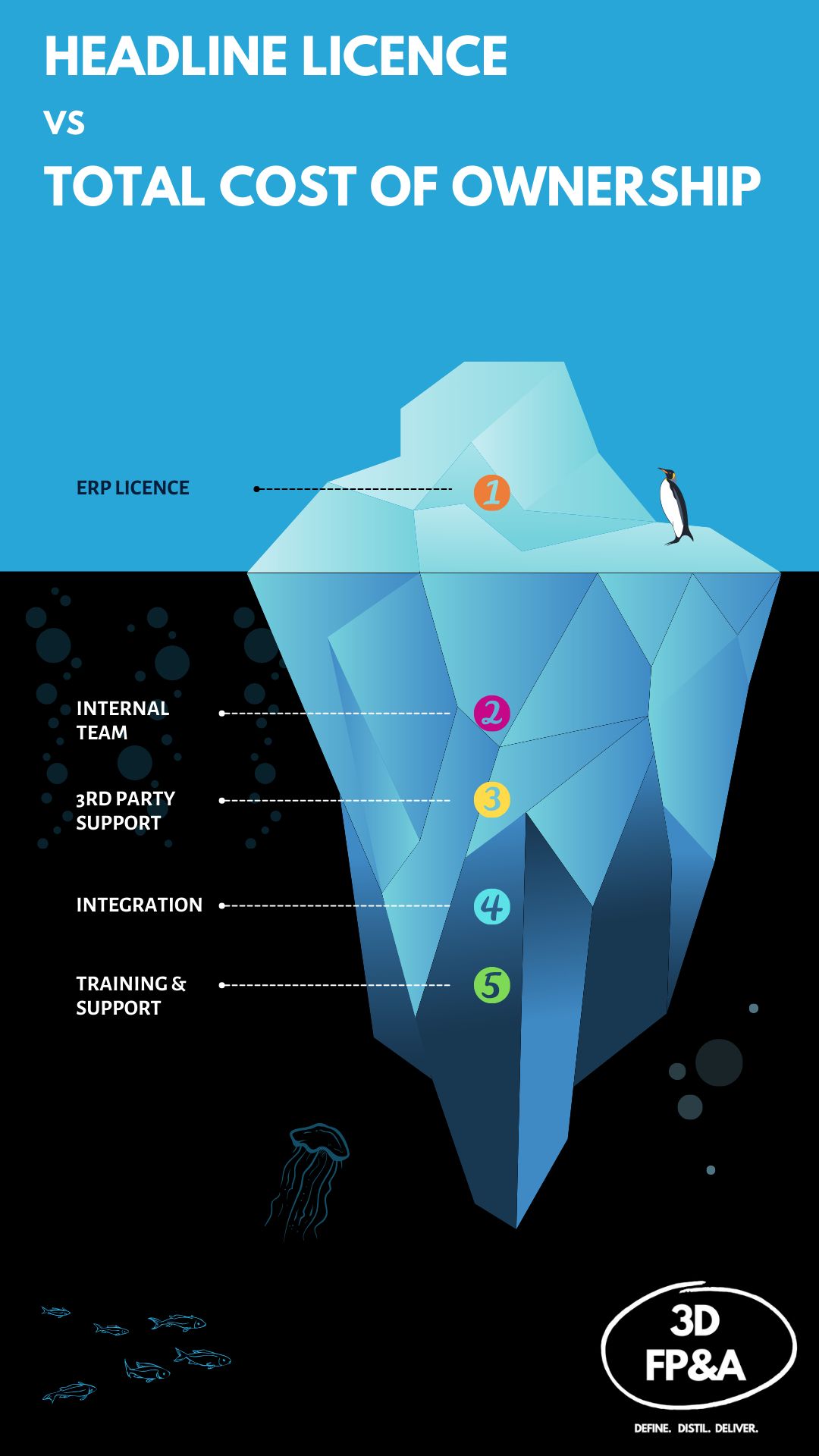
Internal teams to run and maintain it
Third-party specialist support
Integration costs with other systems
Training and ongoing support
Each layer adds to your total cost of ownership. That "£500k" system? By the time you factor in everything below the waterline, you're looking at nearly double the headline cost.
This isn't unique to ERP systems. Whether it's a new HR platform, building connectivity, or a new planning tool - looking only at the license cost is like judging an iceberg by what you can see above water.
In my experience, the simplest way to group costs by total cost of ownership is as follows:
Licence (headline platform)
Internal resource (who on the payroll is running & maintaining the service)
3rd party support (contractors, ancillary tools)
Combine these 2 frameworks and we can transform how we view spend across technology.
Go back to that Service Delivery example - reporting straight out of the GL doesn’t shine too much light on what the team is bringing to the table.
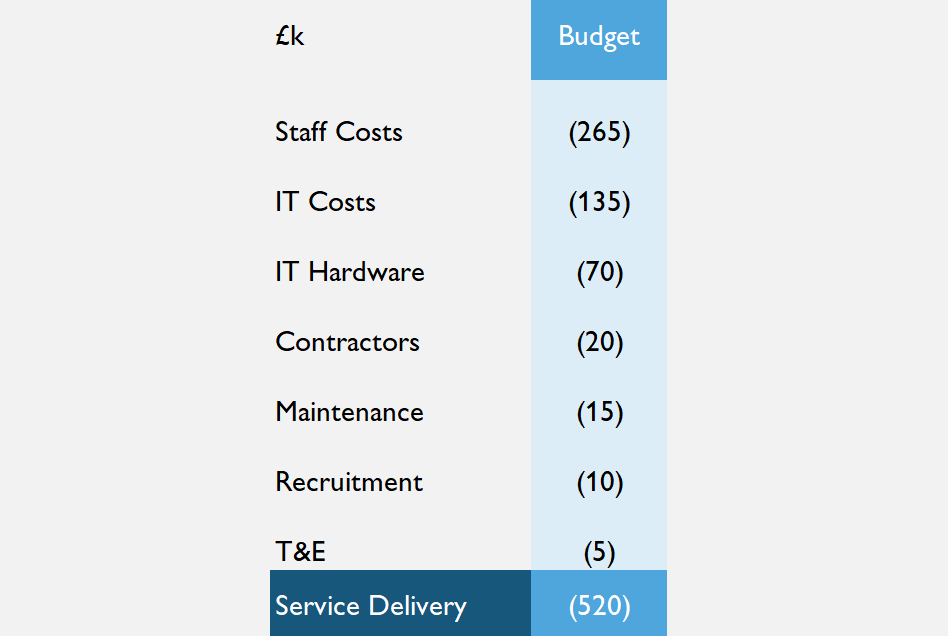
But organise costs by service line & total cost of ownership, the story becomes a lot clearer…
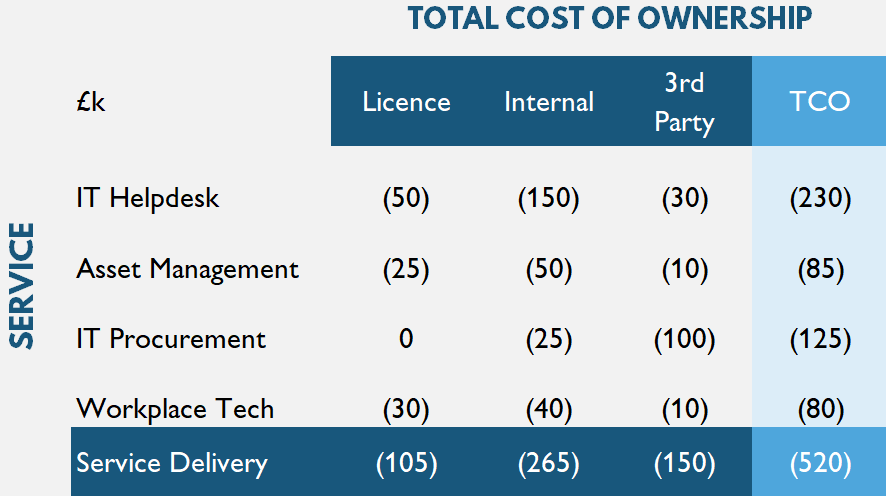
As with all parts of FP&A, moving the needle comes from going past the limitations of financial systems and really taking the time with your Technology partners to gain a deeper understanding of their goals, challenges & pain points.
NEXT STEPS: BUILD YOUR TECH TRANSLATION SKILLS
Really get to know the Technology team (pick one team lead)
What business needs are they trying to address?
How are they currently trying to serve them?
What are their biggest pain points?
What would they change now if they could?
Map out their business needs hierarchy
What specific business problems are they tasked to solve?
What services do they deliver to address them?
How is the team built to deliver them?
Get into the weeds of the financials
What are the list of vendors that the team use?
Who’s on the payroll of this team?
Map out licence, internal resource & 3rd party costs to each service line.
Any gaps? That’s where we go back to the team, refining the picture and improving our understanding.
Explain the team to your boss
How clearly & succinctly can you explain the financial performance of the team?
Remember: In a world where technology drives business success, being able to translate tech speak into business value isn't just helpful - it's essential.
REFERENCE: TECH TEAM GUIDE
Understanding these frameworks helps us make sense of how a typical technology function is structured. Each team serves specific business needs, delivers distinct services, and carries its own total cost of ownership profile.
Below is a breakdown of the key technology teams, their core purpose, and main services you may typically find in an enterprise-level organisation:
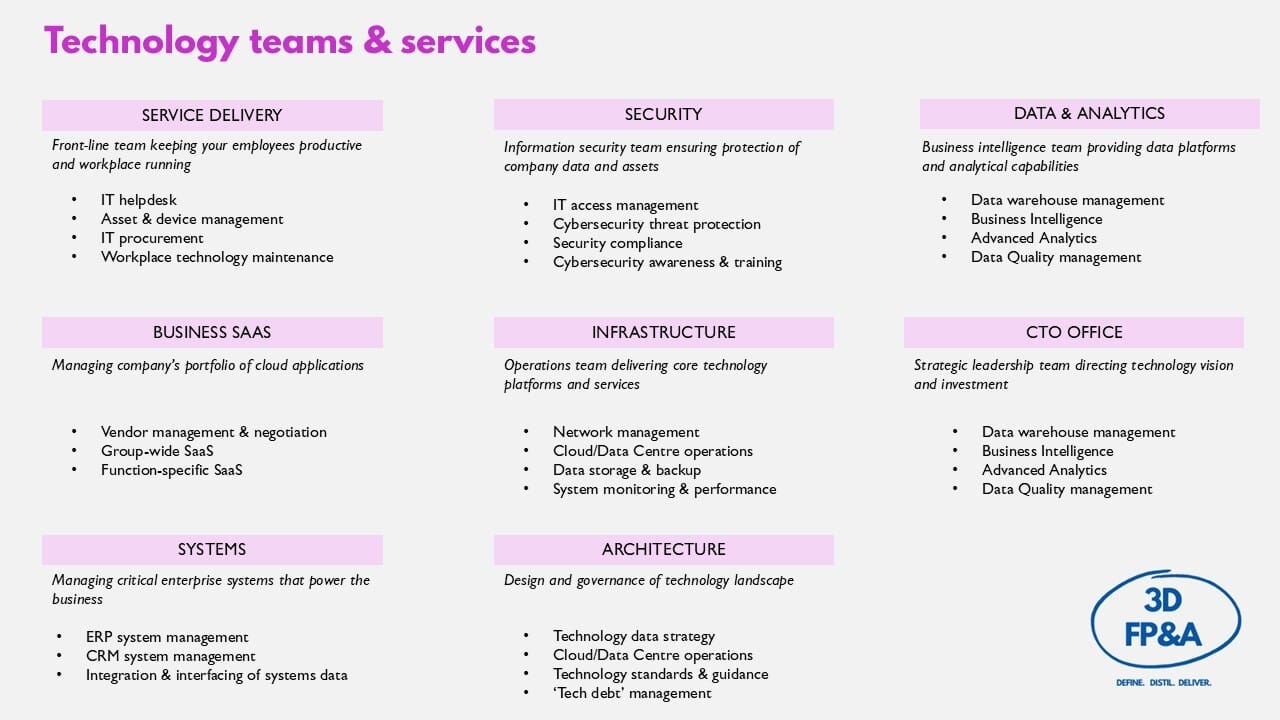
Think of it as layers of support:
Front-line teams (Service Delivery, Business SaaS) interfacing directly with users
Core delivery teams (Systems, Security, Infrastructure) providing the foundation
Strategic teams (Architecture, CTO Office, Data & Analytics) driving future direction
Ready to transform how you view technology costs? Drop a comment below sharing your biggest technology reporting challenge. Let's solve this together. 👇